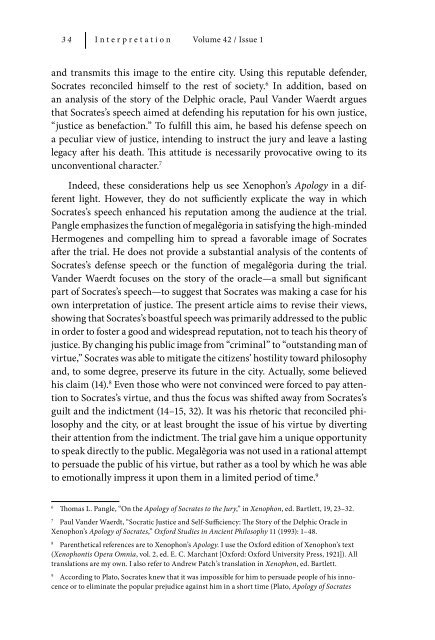Fall 2015
Vol_42_1
Vol_42_1
- No tags were found...
Create successful ePaper yourself
Turn your PDF publications into a flip-book with our unique Google optimized e-Paper software.
3 4 I n t e r p r e t a t i o n Volume 42 / Issue 1<br />
and transmits this image to the entire city. Using this reputable defender,<br />
Socrates reconciled himself to the rest of society. 6 In addition, based on<br />
an analysis of the story of the Delphic oracle, Paul Vander Waerdt argues<br />
that Socrates’s speech aimed at defending his reputation for his own justice,<br />
“justice as benefaction.” To fulfill this aim, he based his defense speech on<br />
a peculiar view of justice, intending to instruct the jury and leave a lasting<br />
legacy after his death. This attitude is necessarily provocative owing to its<br />
unconventional character. 7<br />
Indeed, these considerations help us see Xenophon’s Apology in a different<br />
light. However, they do not sufficiently explicate the way in which<br />
Socrates’s speech enhanced his reputation among the audience at the trial.<br />
Pangle emphasizes the function of megalēgoria in satisfying the high-minded<br />
Hermogenes and compelling him to spread a favorable image of Socrates<br />
after the trial. He does not provide a substantial analysis of the contents of<br />
Socrates’s defense speech or the function of megalēgoria during the trial.<br />
Vander Waerdt focuses on the story of the oracle—a small but significant<br />
part of Socrates’s speech—to suggest that Socrates was making a case for his<br />
own interpretation of justice. The present article aims to revise their views,<br />
showing that Socrates’s boastful speech was primarily addressed to the public<br />
in order to foster a good and widespread reputation, not to teach his theory of<br />
justice. By changing his public image from “criminal” to “outstanding man of<br />
virtue,” Socrates was able to mitigate the citizens’ hostility toward philosophy<br />
and, to some degree, preserve its future in the city. Actually, some believed<br />
his claim (14). 8 Even those who were not convinced were forced to pay attention<br />
to Socrates’s virtue, and thus the focus was shifted away from Socrates’s<br />
guilt and the indictment (14–15, 32). It was his rhetoric that reconciled philosophy<br />
and the city, or at least brought the issue of his virtue by diverting<br />
their attention from the indictment. The trial gave him a unique opportunity<br />
to speak directly to the public. Megalēgoria was not used in a rational attempt<br />
to persuade the public of his virtue, but rather as a tool by which he was able<br />
to emotionally impress it upon them in a limited period of time. 9<br />
6<br />
Thomas L. Pangle, “On the Apology of Socrates to the Jury,” in Xenophon, ed. Bartlett, 19, 23–32.<br />
7<br />
Paul Vander Waerdt, “Socratic Justice and Self-Sufficiency: The Story of the Delphic Oracle in<br />
Xenophon’s Apology of Socrates,” Oxford Studies in Ancient Philosophy 11 (1993): 1–48.<br />
8<br />
Parenthetical references are to Xenophon’s Apology. I use the Oxford edition of Xenophon’s text<br />
(Xenophontis Opera Omnia, vol. 2, ed. E. C. Marchant [Oxford: Oxford University Press, 1921]). All<br />
translations are my own. I also refer to Andrew Patch’s translation in Xenophon, ed. Bartlett.<br />
9<br />
According to Plato, Socrates knew that it was impossible for him to persuade people of his innocence<br />
or to eliminate the popular prejudice against him in a short time (Plato, Apology of Socrates


